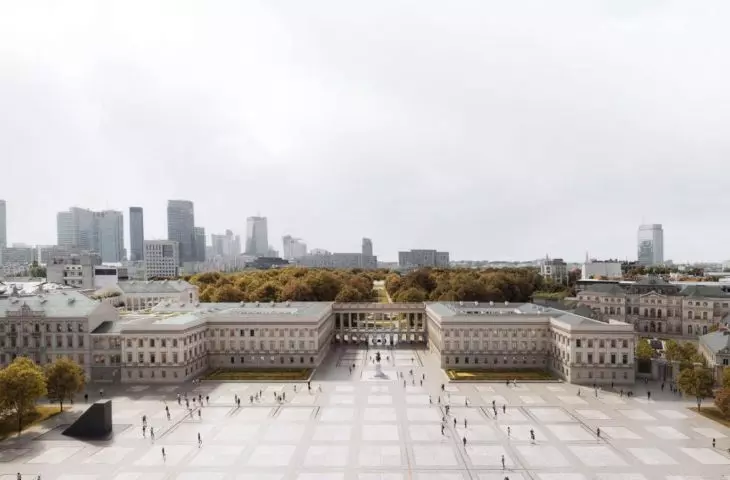TheInternational Architecture Award 2024 - an international award given for the 19th time by the Chicago Athenaeum Museum of Architecture and Design and the European Center for Architecture Art Design and Urban Studies - this year went to three Polish studios. Two completed buildings received it: The Water Factory in Szczecin (proj.: TKHolding), the Baltic Apartments in Swinoujscie (proj.: maxberg) and one project: the concept for the reconstruction of the Saski Palace in Warsaw (proj.: WXCA).
Concept for the reconstruction of the Saski Palace and Brühl Palace in Warsaw.
© WXCA
To rebuild or not to rebuild?
The as-yet unrealized vision for rebuilding the complex of the Saski Palace, Brühl Palace and townhouses on Królewska Street in Warsaw, destroyed during World War II, was selected last year in a competition organized by the Ministry of Culture and National Heritage in cooperation with the Association of Polish Architects. The very idea of the competition aroused a widely debated controversy - there were voices both supporting the reconstruction, encouraging the ordering of the chaotic development of Pilsudski Square in Warsaw through the introduction of completely new solutions, and suggesting leaving the place empty - a place of remembrance that, surrounding the Tomb of the Unknown Soldier, would remind us of the wartime tragedy.
Read more: A place of memory, a place of dementia. A reflection on the idea of reconstructing the Saxon Palace
In the end, it was decided to reconstruct it - the western frontage of Pilsudski Square is to return to its pre-war state. At that time it consisted of the neoclassical Saski Palace, rebuilt in the 19th century, the rococo Brühl Palace designed by Tylman of Gameren with interference from Bohdan Pniewski in the 1930s, the modernist Beck Pavilion and three city tenements on the side of Królewska Street. The competition jury, chaired by Marek Dunikowski, appreciated the WXCA team's consideration of the broader urban context and the adequacy of the proposed architecture to the function, rank and location of the buildings.
Read more: WXCA Studio won the competition for the design of the reconstruction of the Saski Palace!
Concept for the reconstruction of the Saski Palace and Brühl Palace in Warsaw
© WXCA
The Saski Palace was the central element of the Saxon Axis, an 18th-century urban layout whose components included Saski Square [since 1928 Pilsudski Square], Saski Palace and Saski Garden. Historically, this was Warsaw's main east-west urban axis - spatially it complemented the Royal Route, being one of the layers of Warsaw's urban structure, at the same time constitutive of the city's identity: a connection between the Old Town and the later, 19th-century downtown area," explains Szczepan Wroński of the WXCA – pracownia architektoniczna studio. - Reconstructing this historical axis, we reach back to the idea of its authors, namely the establishment of a representative public space. Our concept for the reconstruction of the Saxon Palace and Brühl Palace restores actual urban space to Pilsudski Square, reconnecting its fabric to the living organism of the city. The rebuilt complex will house the Senate, the Mazovian Provincial Office and the headquarters of cultural institutions. Thus, this is a unique opportunity to create a complex of public use in the full sense of the word, which at the same time will give an appropriate compositional and symbolic setting to the most important square in the country," the architect adds.
Concept for the reconstruction of the Saxon Palace and Brühl Palace in Warsaw
© WXCA
too early for laurels?
More than 850 projects and realizations from around the world qualified for this year's International Architecture Award. The registration fee is 395 euros. Proposals in 26 categories were judged by a jury consisting of: Claudia Donà, journalist and design critic, architect and designer Flavio Manzoni, Luke Pearson, co-founder and director of the Pearson Lloyd studio, and Silvio Pietro Angori, CEO of the Pininfarina design studio. The Saxon Palace reconstruction concept won the award in the Restoration/renovation category, in which 17 other sites were also recognized.
Concept for the reconstruction of the Saski Palace and Brühl Palace in Warsaw.
© WXCA
While it is always gratifying for Polish architects to be recognized internationally, the question arises whether projects at such an early stage should compete on the same terms as completed investments? Especially since it is still unclear how the fate of this reconstruction will unfold - although Bartlomiej Sienkiewicz, the previous minister of culture and national heritage, announced actions in this direction, Hanna Wroblewska, the current minister, seems to be a bit more reserved on this issue:
Saski Palace is being implemented by a law that is not under my authority. Whatever decision is made - for which we still have time - we have to face the idea that Pilsudski Square, as it looks today, cannot look like this ultimately, whether we decide to rebuild Saski Palace or not. The issue of this part of Warsaw is crucial for us in terms of social, architectural, urban planning.
Concept for the reconstruction of the Saski Palace and the Brühl Palace in Warsaw
© WXCA















































